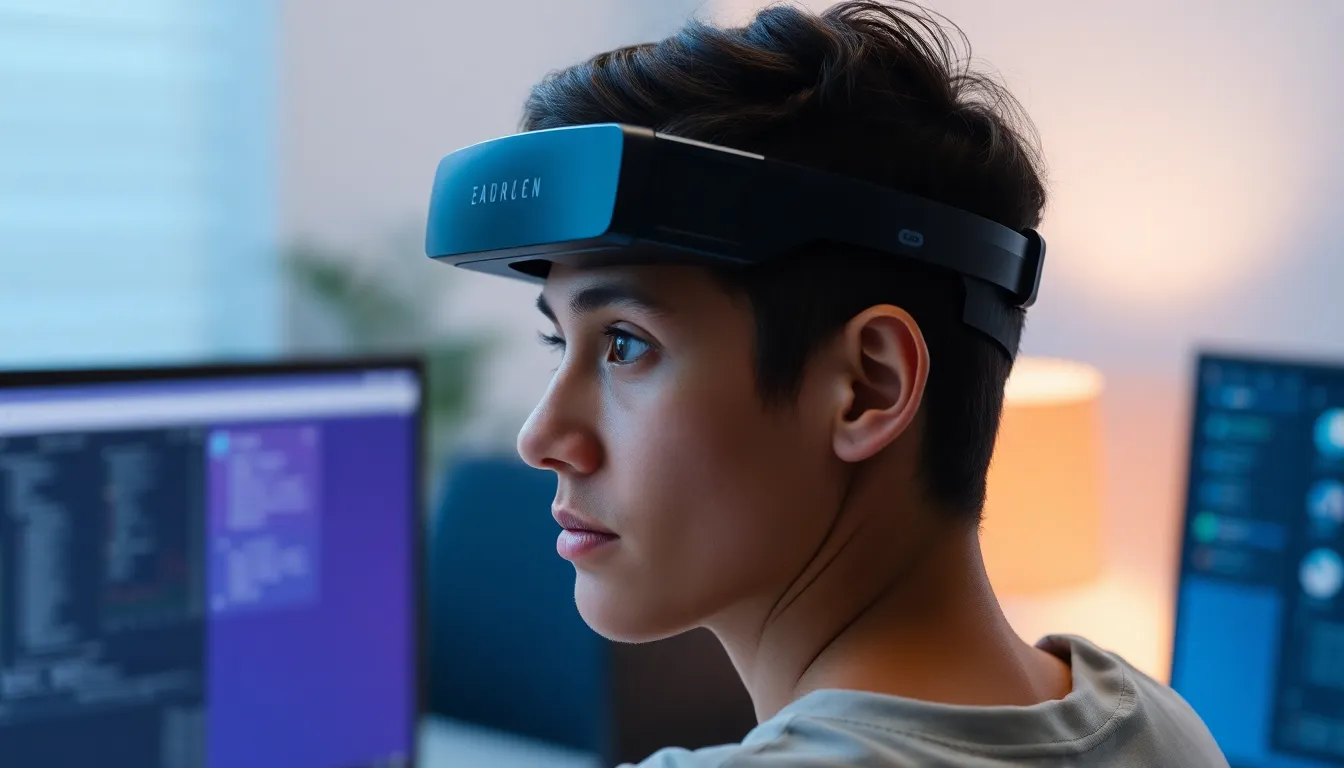Imagine a world where your wearable tech knows exactly where you’re looking—no, not just at that last slice of pizza. Wearables that track eye movements are revolutionizing how we interact with technology, making it smarter and more intuitive. These nifty gadgets are not just for tech enthusiasts; they’re for anyone who wants to enhance their daily life with a dash of innovation and a sprinkle of fun.
From gaming to health monitoring, eye-tracking wearables are turning heads—literally! They can help improve focus, boost productivity, and even transform how we experience entertainment. With features that can track every blink and gaze, these devices are like having a personal assistant that’s always watching your every move (in a good way, of course). Get ready to dive into the fascinating world of eye-tracking wearables and discover how they can elevate your everyday experiences.
Table of Contents
ToggleOverview of Eye-Tracking Wearables
Eye-tracking wearables represent a significant advancement in personal technology. These devices integrate sensors and cameras to monitor eye movements accurately. They facilitate seamless interaction with digital content, allowing users to navigate applications and devices effortlessly.
User experience improves dramatically through the ability to control devices with just eye gestures. For instance, one can scroll through a webpage or select options in an app by simply looking at them. This feature enhances accessibility for individuals with mobility challenges and offers an intuitive interface for all users.
Moreover, many of these wearables gather data on visual attention and focus. Such insights can help users understand their habits, improve productivity and enhance learning experiences. In educational settings, eye-tracking wearables provide teachers with valuable feedback on student engagement and attention levels.
Entertainment also undergoes transformation with these devices. Gaming experiences become more immersive as players interact with environments using their eyes. Similarly, virtual reality platforms utilize eye tracking to create more realistic simulations, enhancing engagement.
Several companies are currently leading innovation in this field. For example, devices from companies like Tobii and Oculus employ eye-tracking technology to deliver enhanced user experiences. The growing range of applications across industries further underscores the potential of these wearables.
As this technology evolves, eye-tracking wearables will likely become more prevalent, impacting daily life significantly. They promise to redefine how individuals interact with technology, making interfaces smarter and more responsive to natural human behavior.
Technology Behind Eye Movement Tracking

Eye movement tracking technology relies on sophisticated components that enable precise detection and analysis of eye behavior. Wearables utilize various methods to achieve accuracy and reliability.
Sensors and Hardware
Cameras capture high-resolution images of the eyes, tracking movements with remarkable precision. Infrared sensors provide illumination, which highlights pupil and corneal reflection. Optical sensors measure the angle of gaze, allowing devices to determine where a user is looking. Integration of miniaturized components maintains comfort and usability. Designs prioritize lightweight structures so users can wear them for extended periods without discomfort. Manufacturers like Tobii and Oculus focus on advancing these technologies to enhance user experience.
Data Processing Techniques
Algorithms analyze data from sensors to interpret eye movements quickly and accurately. Machine learning enables continuous improvement in gaze prediction and focus detection. Real-time processing allows immediate feedback, enhancing user interaction with applications. Data filtering techniques reduce noise, ensuring accurate readings in various environments. Analytics provide insights into attention patterns, helping users understand visual habits. These techniques collectively boost the effectiveness of eye-tracking wearables, enriching both personal and professional applications.
Applications of Eye-Tracking Wearables
Eye-tracking wearables find diverse applications across various fields, enhancing user experiences and providing valuable insights.
Health Monitoring
Health monitoring represents a crucial application of eye-tracking wearables. These devices can assess eye movement patterns to detect symptoms of conditions such as ADHD or autism. They facilitate remote patient monitoring, allowing healthcare providers to gather data on patient behavior. Tracking visual attention helps healthcare professionals make informed decisions regarding treatment plans. The technology also supports rehabilitation efforts, enabling therapists to evaluate progress in patients recovering from strokes or other injuries.
Gaming and Virtual Reality
Gaming and virtual reality benefit significantly from eye-tracking technology. Players can engage more deeply with immersive experiences, using eye movements to control in-game actions. Eye-tracking wearables enhance realism, allowing for more intuitive interactions. This technology supports dynamic visual environments where gaze direction influences game narratives. Developers harness these insights to craft experiences that react in real-time, adapting to player focus and interest.
Assistive Technologies
Assistive technologies leverage eye-tracking wearables to empower individuals with disabilities. These devices enable hands-free interaction with computers and smartphones, enhancing accessibility for those with limited mobility. Users can control cursors and select items simply by looking at them, streamlining everyday tasks. Moreover, eye-tracking technology aids in communication for non-verbal individuals, providing a means to express thoughts through eye movements. This innovation fosters greater independence and improved quality of life.
Benefits of Using Eye-Tracking Wearables
Eye-tracking wearables offer a range of advantages, significantly enhancing various aspects of daily life and user interaction.
Enhanced User Experience
These devices create more intuitive interfaces for interacting with technology. Improved navigation becomes possible as users can control applications simply by looking at them. Engagement increases when eye movement seamlessly translates into commands, reducing the need for physical input. Users also enjoy personalized feedback based on their visual habits, leading to tailored experiences in gaming and virtual environments. Immersion deepens as entertainment becomes more responsive to the user’s gaze, enhancing overall enjoyment.
Increased Accessibility
Eye-tracking wearables revolutionize accessibility for individuals with mobility challenges. Such devices enable hands-free control through eye movements, allowing users to operate smartphones and computers effortlessly. Communication improves for non-verbal individuals, facilitating interaction with speech-generating devices. The potential for independent living rises as users navigate technology through visual attention. Enhanced learning opportunities emerge as these wearables provide insights into engagement levels, benefiting educational environments and enabling tailored support for diverse learners.
Challenges and Limitations
Eye-tracking wearables face several challenges that impact their functionality and acceptance in daily use. Privacy concerns persist due to the sensitive nature of eye movement data. Users may worry about data collection and how their information is used. Furthermore, face recognition features integrated into eye-tracking technology can raise alarm over unauthorized surveillance.
Accuracy and reliability issues also affect the effectiveness of these devices. Factors such as lighting conditions, face orientation, and glasses can compromise tracking precision. Misalignment of eye-tracking sensors impacts the quality of data collected, which in turn affects user experience. Continuous software updates and calibrations may be needed to maintain optimal performance. While the technology is advancing, ensuring consistent accuracy remains a vital focus for developers in this evolving field.
Eye-tracking wearables are set to revolutionize how individuals engage with technology. Their ability to enhance productivity and accessibility opens up new possibilities across various fields. As these devices become more sophisticated and widespread, users will benefit from more intuitive interactions and personalized experiences.
The potential applications in health monitoring education and entertainment highlight their versatility. However addressing privacy concerns and ensuring consistent accuracy will be essential for widespread adoption. As the technology continues to evolve it promises to redefine user experiences and empower individuals in ways previously unimaginable.



